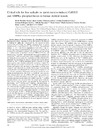Please use this identifier to cite or link to this item:
https://accedacris.ulpgc.es/jspui/handle/10553/44477
| Title: | Critical role for free radicals on sprint exercise-induced CaMKII and AMPKα phosphorylation in human skeletal muscle | Authors: | Morales-Alamo, David Ponce-González, Jesús Gustavo Guadalupe Grau, Amelia Rodríguez-García, Lorena Santana, Alfredo Cusso, Roser Guerrero, Mario Dorado, Cecilia Guerra, Borja Calbet, José A.L. |
UNESCO Clasification: | 241106 Fisiología del ejercicio | Keywords: | Antioxidants AMP-Activated Protein Kinase Exercise Fatigue Sprint |
Issue Date: | 2013 | Publisher: | 8750-7587 | Project: | Integracion de Los Grupos de la Obesidad y El Síndrome Metabólico .... | Journal: | Journal of Applied Physiology | Abstract: | The extremely high energy demand elicited by sprint exercise is satisfied by an increase in O2 consumption combined with a high glycolytic rate, leading to a marked lactate accumulation, increased AMP-to-ATP ratio, and reduced NAD+/NADH.H+ and muscle pH, which are accompanied by marked Thr172 AMP-activated protein kinase (AMPK)-α phosphorylation during the recovery period by a mechanism not fully understood. To determine the role played by reactive nitrogen and oxygen species (RNOS) on Thr172-AMPKα phosphorylation in response to cycling sprint exercise, nine voluntary participants performed a single 30-s sprint (Wingate test) on two occasions: one 2 h after the ingestion of placebo and another after the intake of antioxidants (α-lipoic acid, vitamin C, and vitamin E) in a double-blind design. Vastus lateralis muscle biopsies were obtained before, immediately postsprint, and 30 and 120 min postsprint. Performance and muscle metabolism were similar during both sprints. The NAD+-to-NADH.H+ ratio was similarly reduced (84%) and the AMP-to-ATP ratio was similarly increased (×21-fold) immediately after the sprints. Thr286 Ca2+/calmodulin- dependent protein kinase II (CaMKII) and Thr172-AMPKα phosphorylations were increased after the control sprint (with placebo) but not when the sprints were preceded by the ingestion of antioxidants. Ser485-AMPKα1/Ser491-AMPKα2 phosphorylation, a known inhibitory mechanism of Thr172-AMPKα phosphorylation, was increased only with antioxidant ingestion. In conclusion, RNOS play a crucial role in AMPK-mediated signaling after sprint exercise in human skeletal muscle. Antioxidant ingestion 2 h before sprint exercise abrogates the Thr172-AMPKα phosphorylation response observed after the ingestion of placebo by reducing CaMKII and increasing Ser485-AMPKα1/Ser491-AMPKα2 phosphorylation. Sprint performance, muscle metabolism, and AMP-to-ATP and NAD+-to- NADH.H+ ratios are not affected by the acute ingestion of. Morales-Alamo D, Ponce-Gonzalez JG, Guadalupe-Grau A, Rodriguez-Garcia L, Santana A, Cusso R, Guerrero M, Dorado C, Guerra B, Calbet JA. Critical role for free radicals on sprint exercise-induced CaMKII and AMPK alpha phosphorylation in human skeletal muscle. J Appl Physiol 114: 566-577, 2013. First published January 3, 2013; doi:10.1152/japplphysiol.01246.2012.-The extremely high energy demand elicited by sprint exercise is satisfied by an increase in O-2 consumption combined with a high glycolytic rate, leading to a marked lactate accumulation, increased AMP-to-ATP ratio, and reduced NAD(+)/NADH.H+ and muscle pH, which are accompanied by marked Thr(172) AMP-activated protein kinase (AMPK)-alpha phosphorylation during the recovery period by a mechanism not fully understood. To determine the role played by reactive nitrogen and oxygen species (RNOS) on Thr(172)-AMPK alpha phosphorylation in response to cycling sprint exercise, nine voluntary participants performed a single 30-s sprint (Wingate test) on two occasions: one 2 h after the ingestion of placebo and another after the intake of antioxidants (alpha-lipoic acid, vitamin C, and vitamin E) in a double-blind design. Vastus lateralis muscle biopsies were obtained before, immediately postsprint, and 30 and 120 min postsprint. Performance and muscle metabolism were similar during both sprints. The NAD(+)-to-NADH.H+ ratio was similarly reduced (84%) and the AMP-to-ATP ratio was similarly increased (x21-fold) immediately after the sprints. Thr(286) Ca2+/cal-modulin-dependent protein kinase II (CaMKII) and Thr(172)-AMPK alpha phosphorylations were increased after the control sprint (with placebo) but not when the sprints were preceded by the ingestion of antioxidants. Ser(485)-AMPK alpha(1)/Ser(491)-AMPK alpha(2) phosphorylation, a known inhibitory mechanism of Thr(172)-AMPK alpha phosphorylation, was increased only with antioxidant ingestion. In conclusion, RNOS play a crucial role in AMPK-mediated signaling after sprint exercise in human skeletal muscle. Antioxidant ingestion 2 h before sprint exercise abrogates the Thr(172)-AMPK alpha phosphorylation response observed after the ingestion of placebo by reducing CaMKII and increasing Ser(485)-AMPK alpha(1)/Ser(491)-AMPK alpha(2) phosphorylation. Sprint performance, muscle metabolism, and AMP-to-ATP and NAD(+)-to-NADH.H+ ratios are not affected by the acute ingestion of antioxidants. |
URI: | https://accedacris.ulpgc.es/handle/10553/44477 | ISSN: | 8750-7587 | DOI: | 10.1152/japplphysiol.01246.2012 | Source: | Journal Of Applied Physiology[ISSN 8750-7587],v. 114 (5), p. 566-577 |
| Appears in Collections: | Artículos |
SCOPUSTM
Citations
51
checked on Jun 8, 2025
WEB OF SCIENCETM
Citations
50
checked on Jun 8, 2025
Page view(s)
91
checked on Mar 9, 2024
Download(s)
217
checked on Mar 9, 2024
Google ScholarTM
Check
Altmetric
Share
Export metadata
Items in accedaCRIS are protected by copyright, with all rights reserved, unless otherwise indicated.
